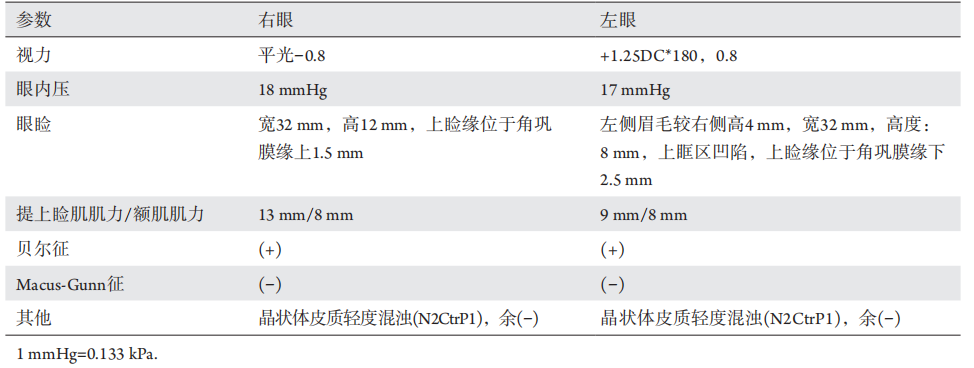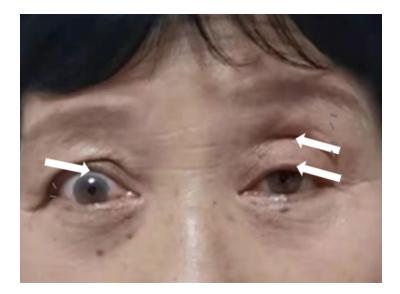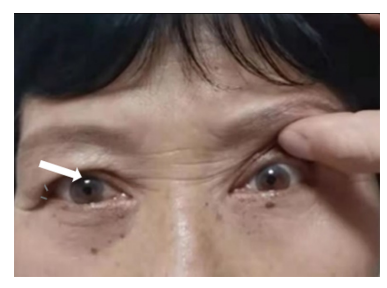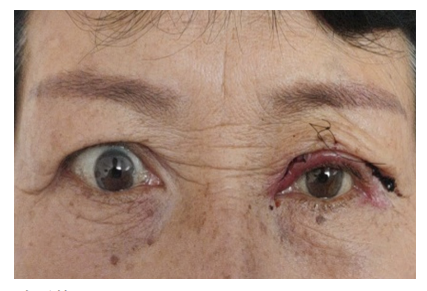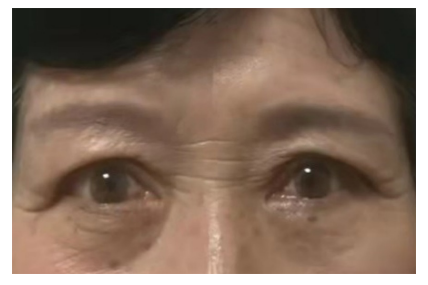1、Bandini F. Pseudo plus-minus lid syndrome[ J]. Arch Neurol, 2009, 66(5): 668-669.Bandini F. Pseudo plus-minus lid syndrome[ J]. Arch Neurol, 2009, 66(5): 668-669.
2、Gaymard B, Lafitte C, Gelot A, et al. Plus-minus lid syndrome[ J]. J Neurol Neurosurg Psychiatry, 1992, 55(9): 846-848.Gaymard B, Lafitte C, Gelot A, et al. Plus-minus lid syndrome[ J]. J Neurol Neurosurg Psychiatry, 1992, 55(9): 846-848.
3、Randhawa S, Donohue MM, Hamilton SR. Concomitant presentation of three rare mesencephalic syndromes: case report[ J]. Clin Neurol Neurosurg, 2010, 112(8): 697-700.Randhawa S, Donohue MM, Hamilton SR. Concomitant presentation of three rare mesencephalic syndromes: case report[ J]. Clin Neurol Neurosurg, 2010, 112(8): 697-700.
4、Akdal G, Kutluk K, Men S, et al. Benedikt and "plus-minus lid" syndromes arising from posterior cerebral artery branch occlusion[ J]. J Neurol Sci, 2005, 228(1): 105-107.Akdal G, Kutluk K, Men S, et al. Benedikt and "plus-minus lid" syndromes arising from posterior cerebral artery branch occlusion[ J]. J Neurol Sci, 2005, 228(1): 105-107.
5、Sorgun MH, I?ikay CT, Kuzu Z. Plus-minus lid syndrome caused by thalamic hematoma[ J]. Acta Neurol Belg, 2014, 114(2): 151-152.Sorgun MH, I?ikay CT, Kuzu Z. Plus-minus lid syndrome caused by thalamic hematoma[ J]. Acta Neurol Belg, 2014, 114(2): 151-152.
6、潘贰, 李勤, 于建刚, 等. 应用赫林定律矫正不对称双侧上睑下垂的临床效果[ J]. 中华医学美学美容杂志, 2017, 23(5): 313-315.
PAN Er, LI Qin, YU Jiangang, et al. Application of the Hering's law in corrective surgery for asymmetric bilateral ptosis[ J]. Chinese Journal of Medical Aesthetics and Cosmetology, 2017, 23(5): 313-315.潘贰, 李勤, 于建刚, 等. 应用赫林定律矫正不对称双侧上睑下垂的临床效果[ J]. 中华医学美学美容杂志, 2017, 23(5): 313-315.
PAN Er, LI Qin, YU Jiangang, et al. Application of the Hering's law in corrective surgery for asymmetric bilateral ptosis[ J]. Chinese Journal of Medical Aesthetics and Cosmetology, 2017, 23(5): 313-315.
7、唐浚杰, 陈芳圆, 陈剑, 等. 成人重症肌无力眼肌型的临床特征[ J]. 中华眼视光学与视觉科学杂志, 2021, 23(8): 604-609.
TANG Junjie, CHEN Fangyuan, CHEN Jian, et al. Analysis of the clinical features of adult ocular Myasthenia gravis[ J]. Chinese Journal of Optometry Ophthalmology and Visual Science, 2021, 23(8): 604-609.唐浚杰, 陈芳圆, 陈剑, 等. 成人重症肌无力眼肌型的临床特征[ J]. 中华眼视光学与视觉科学杂志, 2021, 23(8): 604-609.
TANG Junjie, CHEN Fangyuan, CHEN Jian, et al. Analysis of the clinical features of adult ocular Myasthenia gravis[ J]. Chinese Journal of Optometry Ophthalmology and Visual Science, 2021, 23(8): 604-609.
8、贺姽娟, 翁胜涛, 李华. 改良式上睑提肌缩短术治疗上睑下垂66眼[ J]. 中华整形外科杂志, 2020, 36(3): 308-312.
HE Guijuan, WENG Shengtao, LI Hua. The treatment of 66 ptosis with a modified aponeurosis-resection surgery[ J]. Chinese Journal of Plastic Surgery, 2020, 36(3): 308-312.贺姽娟, 翁胜涛, 李华. 改良式上睑提肌缩短术治疗上睑下垂66眼[ J]. 中华整形外科杂志, 2020, 36(3): 308-312.
HE Guijuan, WENG Shengtao, LI Hua. The treatment of 66 ptosis with a modified aponeurosis-resection surgery[ J]. Chinese Journal of Plastic Surgery, 2020, 36(3): 308-312.
9、曹琳, 郑仁东, 曹雯,等. 甲状腺相关性眼病治疗新进展[ J]. 国际内分泌代谢杂志, 2019, 39(1): 25-28.
CAO Lin, ZHEGN Rendong, CAO Wen, et al. Update on the management of thyroid-associated ophthalmopathy[ J]. International Journal of Endocrinology and Metabolism, 2019, 39(1): 25-28.曹琳, 郑仁东, 曹雯,等. 甲状腺相关性眼病治疗新进展[ J]. 国际内分泌代谢杂志, 2019, 39(1): 25-28.
CAO Lin, ZHEGN Rendong, CAO Wen, et al. Update on the management of thyroid-associated ophthalmopathy[ J]. International Journal of Endocrinology and Metabolism, 2019, 39(1): 25-28.
10、尚巧利, 蒋海越. 先天性上睑下垂的手术治疗[ J]. 中华医学美学美容杂志, 2016, 22(3): 191-192.
SAHNG Qiaoli, JIANG Haiyue. Surgical treatment of congenital ptosis[ J]. Chinese Journal of Medical Aesthetics and Cosmetology, 2016, 22(3): 191-192.尚巧利, 蒋海越. 先天性上睑下垂的手术治疗[ J]. 中华医学美学美容杂志, 2016, 22(3): 191-192.
SAHNG Qiaoli, JIANG Haiyue. Surgical treatment of congenital ptosis[ J]. Chinese Journal of Medical Aesthetics and Cosmetology, 2016, 22(3): 191-192.
11、黄鑫宇, 王星星, 许海涛, 等. 伴假性Graefe征动眼神经麻痹后上睑下垂三例治疗观察[ J]. 中华医学美学美容杂志, 2019, 25(2):193-197.
HUANG Xinyu, WANG Xingxing, XU Haitao, et al. Treatment of blepharoptosis with pseudo-Graefe phenomenon caused by oculomotor nerve paralysis: report of three cases[ J]. Chinese Journal of Medical Aesthetics and Cosmetology, 2019, 25(2): 193-197.黄鑫宇, 王星星, 许海涛, 等. 伴假性Graefe征动眼神经麻痹后上睑下垂三例治疗观察[ J]. 中华医学美学美容杂志, 2019, 25(2):193-197.
HUANG Xinyu, WANG Xingxing, XU Haitao, et al. Treatment of blepharoptosis with pseudo-Graefe phenomenon caused by oculomotor nerve paralysis: report of three cases[ J]. Chinese Journal of Medical Aesthetics and Cosmetology, 2019, 25(2): 193-197.
12、庞润晖, 张宏斌, 李妍, 等. 老年性上睑下垂退行性改变个性化治疗临床分析[ J]. 中国实用眼科杂志, 2015, 33(11): 1306-1308.
PANG Runhui, ZHANG Hongbin, LI Yan, et al. Observation of individual therapeutic methods based on degenerative change of levator aponeurosis in patients with senile ptosis[ J]. Chinese Journal of Practical Ophthalmology, 2015, 33(11): 1306-1308.庞润晖, 张宏斌, 李妍, 等. 老年性上睑下垂退行性改变个性化治疗临床分析[ J]. 中国实用眼科杂志, 2015, 33(11): 1306-1308.
PANG Runhui, ZHANG Hongbin, LI Yan, et al. Observation of individual therapeutic methods based on degenerative change of levator aponeurosis in patients with senile ptosis[ J]. Chinese Journal of Practical Ophthalmology, 2015, 33(11): 1306-1308.
13、祝玮烨, 杨超, 邢新. 正负眼睑综合征[ J]. 中国美容整形外科杂志, 2017, 28(9): 548-550.
ZHU Weihua, YANG Chao, XING Xin. Puls-minus lid syndrome[ J]. Chinese Journal of Aesthetic and Plastic Surgery, 2017, 28(9): 548-550.祝玮烨, 杨超, 邢新. 正负眼睑综合征[ J]. 中国美容整形外科杂志, 2017, 28(9): 548-550.
ZHU Weihua, YANG Chao, XING Xin. Puls-minus lid syndrome[ J]. Chinese Journal of Aesthetic and Plastic Surgery, 2017, 28(9): 548-550.
14、梅媚. 老年腱膜性上睑下垂的个性化手术治疗[ J]. 临床眼科杂志, 2018, 26(2): 164-165.
MEI Mei. Individualized surgical treatment for senile ptosis[ J]. Journal of Clinical Ophthalmology, 2018, 26(2): 164-165.梅媚. 老年腱膜性上睑下垂的个性化手术治疗[ J]. 临床眼科杂志, 2018, 26(2): 164-165.
MEI Mei. Individualized surgical treatment for senile ptosis[ J]. Journal of Clinical Ophthalmology, 2018, 26(2): 164-165.
15、Zoumalan CI, Lisman RD. Evaluation and management of unilateral ptosis and avoiding contralateral ptosis[ J]. Aesthet Surg J, 2010, 30(3): 320-328.Zoumalan CI, Lisman RD. Evaluation and management of unilateral ptosis and avoiding contralateral ptosis[ J]. Aesthet Surg J, 2010, 30(3): 320-328.
16、《上睑下垂诊治专家共识》制定专家组. 上睑下垂诊治专家共识[ J]. 中华医学杂志, 2017, 97(6): 406-411.
Expert group for formulating "Expert Consensus on Diagnosis and Treatment of ptosis". Expert consensus on diagnosis and treatment of ptosis[ J]. National Medical Journal of China, 2017, 97(6): 406-411.《上睑下垂诊治专家共识》制定专家组. 上睑下垂诊治专家共识[ J]. 中华医学杂志, 2017, 97(6): 406-411.
Expert group for formulating "Expert Consensus on Diagnosis and Treatment of ptosis". Expert consensus on diagnosis and treatment of ptosis[ J]. National Medical Journal of China, 2017, 97(6): 406-411.
17、庄艾, 孙静, 张硕, 等. 异种脱细胞真皮植入术治疗甲状腺相关眼病眼睑退缩的临床观察[ J]. 中华眼科杂志, 2019, 55(11):821-827.
ZHUANG Ai, SUN Jing, ZHANG Shuo, et al. Acellular xenogenic dermal matrix as a spacer graft for treatment of eyelid retraction related to thyroid associated ophthalmopathy[ J]. Chinese Journal of Ophthalmology, 2019, 55(11): 821-827.庄艾, 孙静, 张硕, 等. 异种脱细胞真皮植入术治疗甲状腺相关眼病眼睑退缩的临床观察[ J]. 中华眼科杂志, 2019, 55(11):821-827.
ZHUANG Ai, SUN Jing, ZHANG Shuo, et al. Acellular xenogenic dermal matrix as a spacer graft for treatment of eyelid retraction related to thyroid associated ophthalmopathy[ J]. Chinese Journal of Ophthalmology, 2019, 55(11): 821-827.
18、Alsherbini K, Kapadia K, Sattin JA. A rare midbrain infarction presenting with plus-minus lid syndrome with ataxia: a case report[ J]. J Med Case Rep, 2011, 5: 525.Alsherbini K, Kapadia K, Sattin JA. A rare midbrain infarction presenting with plus-minus lid syndrome with ataxia: a case report[ J]. J Med Case Rep, 2011, 5: 525.
19、Worley MW, Gal O, Anderson RL, et al. Eye dominance and Hering's law effect on bilateral blepharotosis repair[ J]. Ophthalmic Plast Reconstr Surg, 2013, 29(6): 437-439.Worley MW, Gal O, Anderson RL, et al. Eye dominance and Hering's law effect on bilateral blepharotosis repair[ J]. Ophthalmic Plast Reconstr Surg, 2013, 29(6): 437-439.

